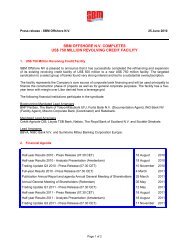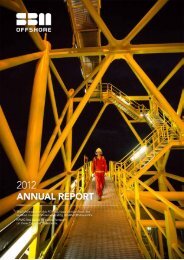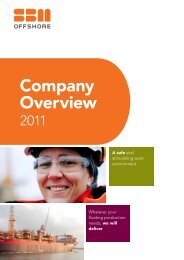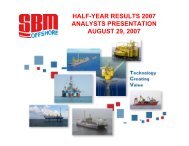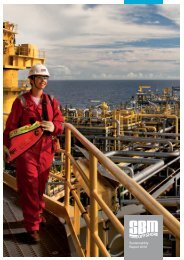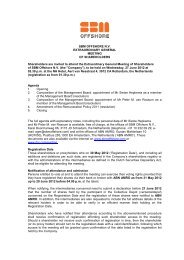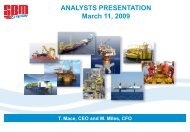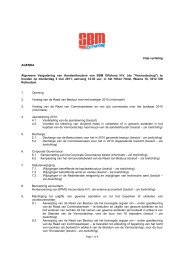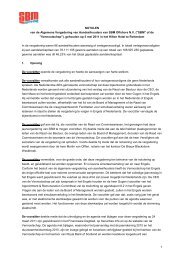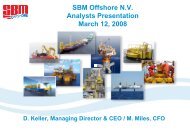2002 Annual Report - SBM Offshore
2002 Annual Report - SBM Offshore
2002 Annual Report - SBM Offshore
Create successful ePaper yourself
Turn your PDF publications into a flip-book with our unique Google optimized e-Paper software.
MANAGEMENT OF RISK<br />
The Group is active in international, custom-built,<br />
high capital value, (mainly) offshore oil production<br />
business. Detailed attention to the management of all<br />
associated risks is critical to the Group’s continuing<br />
success.<br />
There are three major categories of risk which IHC<br />
Caland addresses, namely:<br />
I Project specific risk<br />
II Structural risk<br />
III Treasury risk<br />
The approach to controlling each category differs<br />
considerably. The first and third categories require<br />
specific procedures and practices to be adopted in the<br />
running of business and financial operations, while the<br />
second requires focus on the very structure of the<br />
company. A brief description of the issues and techniques<br />
utilised in the management of risk follows:<br />
I Project specific risk<br />
These are discussed in the sequential order in which they<br />
occur on a typical project.<br />
(A) Construction contracts<br />
Technical risk<br />
In all Group companies, the vast majority (by value) of<br />
projects relates to custom-built products, which are<br />
often required to meet specific performance criteria<br />
established by customers, including adherence to the<br />
rules set by Classification Authorities. Intrinsically, every<br />
new design carries with it new technical risks. Only<br />
extensive technical experience and expertise, together<br />
with strict adherence to internal quality and safety<br />
procedures (on the basis of which the Group’s offshore<br />
companies have obtained ISO-9000 and SEP<br />
accreditation) can manage these risks.<br />
During execution of the project, the design is appraised<br />
and should be approved by the appropriate Classification<br />
Authority, such as Lloyds Register, the American Bureau<br />
of Shipping (ABS), DET Norske Veritas (DNV), Bureau<br />
Veritas, etc. To a large extent, this approval then provides<br />
the security that from a technical angle the project will<br />
be sound and its risks limited.<br />
Budget (sales price) risk<br />
The cost of a product is driven by the technical solution<br />
developed by the Group’s engineers. No amount of risk<br />
control procedures can solve the problem when the<br />
agreed sales price or budgeted capex value for a lease<br />
FPSO is less than the cost price! Accordingly, before a<br />
price is submitted to a client, the detailed calculation is<br />
reviewed and approved by all appropriate departmental<br />
heads, and various levels of management depending on<br />
26<br />
the value of the project. All components of the cost price,<br />
including internal man-hours, subcontracted and<br />
purchased items, insurance and finance costs are carefully<br />
reviewed. Where appropriate the price is adjusted<br />
for the effect of selling or purchasing in foreign currencies.<br />
During execution, the budget is constantly checked<br />
against actual costs, to identify any variances at the<br />
earliest possible stage, and to allow remedial action<br />
where possible. As a final safeguard, for sales projects,<br />
the profit is only recognised upon completion and full<br />
acceptance by the client.<br />
Execution risk<br />
Execution (construction and in some cases installation<br />
offshore) of a project may face all kinds of problems<br />
ranging from mistakes and accidents in the actual<br />
construction phase, bad workmanship, damage during<br />
sea-tow, installation, etc. These risks are always<br />
insured with first class underwriters. The risk of losses<br />
arising from a faulty design cannot be insured in the<br />
market.<br />
There is also the risk of subcontractors who run into<br />
financial problems. This is addressed by credit checks<br />
and requesting bank guarantees to support performance,<br />
followed by careful monitoring of progress. Problems<br />
can nonetheless still occasionally arise.<br />
van der Giessen-de Noord<br />
The problems experienced by van der Giessen-de Noord<br />
during <strong>2002</strong> were mainly due to Budget risk and<br />
Execution risk. The two vessels where most problems<br />
were encountered were both based on the client’s design.<br />
The review procedures detailed to eliminate design and<br />
budget risk were not properly respected, causing an<br />
underestimation of the complexity of the vessels, with<br />
the result that the sales prices were far below the actual<br />
cost.<br />
The problems were compounded in execution by<br />
inefficiencies due to frictions with and poor performance<br />
of some subcontractors who apparently underestimated<br />
their part of the job. Appropriate measures have been<br />
taken to prevent a recurrence of this failure.<br />
Payment risk<br />
Except in the case of first class customers, all payments<br />
due in respect of supply contracts should be covered by<br />
Letters of Credit. For the dredger/shipbuilding activities,<br />
there is also the alternative that payments are insured<br />
with the Dutch Credit Insurance Company (NCM<br />
Gerlings).<br />
(B) FPSO lease and operation<br />
An additional set of risks arises when the Group leases<br />
and operates an FPSO for a client. These include the<br />
following:



